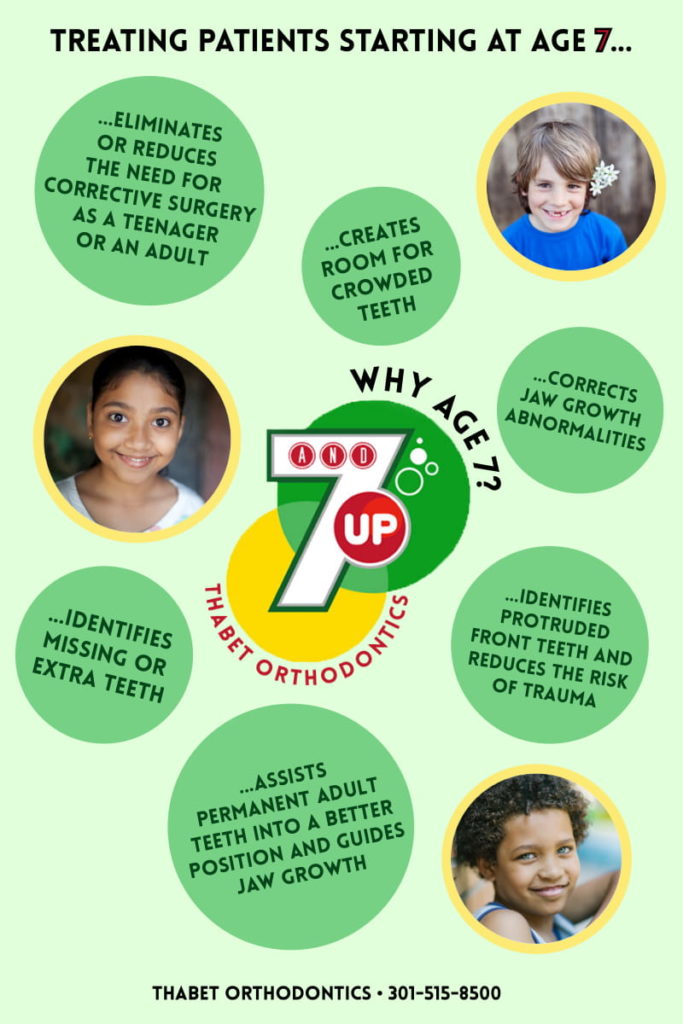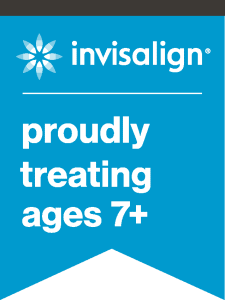Orthodontists recommend that you bring your child in for a first visit by the age of seven. At this point, your child may not need any orthodontic intervention, but it is better to be proactive than too late! Any orthodontic work done during these early years is termed phase one treatment, and it typically takes place between ages 6 to 9. Phase one treatment is aimed at helping the jaw develop in a way that is favorable for permanent teeth that are growing in. At this age, your child will likely have a mix of baby teeth and adult teeth, which is fine because phase one is focusing on the position of the jaw, not on straightening the teeth yet.

What Kind of Orthodontic Care Might Be Recommended for My Child?
Possible orthodontic treatments for phase one can include headgear, expanders, braces, retainers, and spacers. All of these devices are designed to improve how the upper and lower jaw interact so that later on in your child’s life, they can enter phase two with the only goal being to straighten the teeth.
Does My Dentist Need to Refer Me to an Orthodontist?
No. Though your dentist may refer you to a specific orthodontist, you can go to any practice that you feel comfortable with. You also can visit our office without a referral, just make a phone call and find a time to come in for a consultation! If your child does not need interceptive orthodontic treatment, Dr. Othman will monitor your child’s growth and development about once every six months until they might need treatment. There is no cost for these visits – the visits are our gift to you.
How Can I Tell If My Child Might Need Braces?
There are many reasons that a child might need braces, some more obvious than others. To err on the side of caution, it is a good idea to bring your child in for an orthodontic consultation when they are still young to get an accurate recommendation from a professional. Some signs that your child might need braces are:
- Thumb sucking even after adult teeth have come in
- Losing baby teeth too early or too late
- Overbite, underbite, or crossbite
- Crowded teeth
- Mouth breathing
Will My Child Be A Candidate for Invisalign First
As your child grows, so do their teeth, which is why ages 6 – 10 is the perfect time to start orthodontic treatment, known as Phase 1 treatment. Invisalign First aligners are a great way to get Phase 1 results that work. These clear aligners are designed to treat various teeth straightening issues in growing children, from complex to simple issues such as crowding, spacing, and narrow dental arches. Invisalign First offers a comfortable fit, which means your little one won’t go through the discomfort of rubbing brackets or poking wires. Below are some benefits Invisalign First treatment can provide:
- Corrects Alignment Problems
- Improves Smile
- Prevents Serious Orthodontic Issues
- Reduces the Duration of Phase 2 Treatment
- Doesn’t Interfere with Sports, Playing Instruments, or Speech
What Happens During Our First Visit? Will My Child Need Treatment?
Your first visit to an orthodontist is meant to establish a relationship with your doctor and to gather information on your child’s situation. Dr. Othman will perform an oral examination where we inspect your child’s mouth, and the team will take photographs and digital impressions to get a clearer understanding of the jaw and soft tissue positions. Our team will be able to better explain what kind of problems need to be addressed and how the treatment would work after doing the examination. Together, we can look at the 3D model of your child’s mouth. At this first visit, your child will likely not receive any treatment. A follow-up appointment can be booked at this time to begin any orthodontic intervention if deemed necessary.
Why Does My Child Need to See an Orthodontist?
Many people think that orthodontics is all about straightening teeth to show off a nice smile, and this is partly true. More importantly, orthodontists work to make sure that your teeth and jaw are in the proper position to avoid any health issues. Problems with the alignment of the jaw can lead to difficulty chewing and speaking, bone erosion, TMJ, and more. Straightening teeth is also more than just cosmetic. Crowded or crooked teeth make it harder to maintain an adequate level of dental hygiene, which can lead to rotting teeth and gum disease. It is better to prevent these kinds of problems by bringing your child to the orthodontist at a young age, rather than leaving them to persist through adulthood when they can be a bit more challenging to treat.
How Will Orthodontic Treatment Help My Child?
Orthodontic treatment contributes to your child’s physical and mental well-being. Orthodontists can detect small discrepancies in your child’s teeth and jaw early on before they become pressing issues. This can save your child from discomfort or self-consciousness in later years, as well as save you time and money in the long run. Setting your child up for success by giving them the gift of a nice, straight smile does more than you know for self-esteem. Your child will never feel the need to hide their smile or laugh due to crooked teeth. Instead, they will have the confidence to proudly share their joy with others around them.


